Financial Management Report: Analysis of Imperial Brands PLC
VerifiedAdded on 2023/01/13
|12
|2647
|86
Report
AI Summary
This report provides a comprehensive analysis of financial management practices at Imperial Brands, a multinational tobacco company. The report delves into the application of financial management principles, with a focus on financial decision-making and its impact on long-term financial sustainability. It includes an overview of financial management concepts and their strategic importance. The main body of the report covers various aspects of financial analysis, including ratio analysis (gross profit margin, net profit margin, current ratio, return on equity, and debt to equity ratio) and investment appraisal techniques (Net Present Value, Payback Period, Accounting Rate of Return, and Internal Rate of Return). The report evaluates the effectiveness of these techniques in supporting financial decision-making, offering recommendations for improvement in the role of accountants and accounting systems. The analysis of the investment appraisal techniques provides a detailed evaluation of a potential project, assessing its profitability and recommending whether the company should invest. The report concludes by critically evaluating the financial decision-making processes that support long-term financial sustainability within Imperial Brands.

Financial
Management
Management
Secure Best Marks with AI Grader
Need help grading? Try our AI Grader for instant feedback on your assignments.
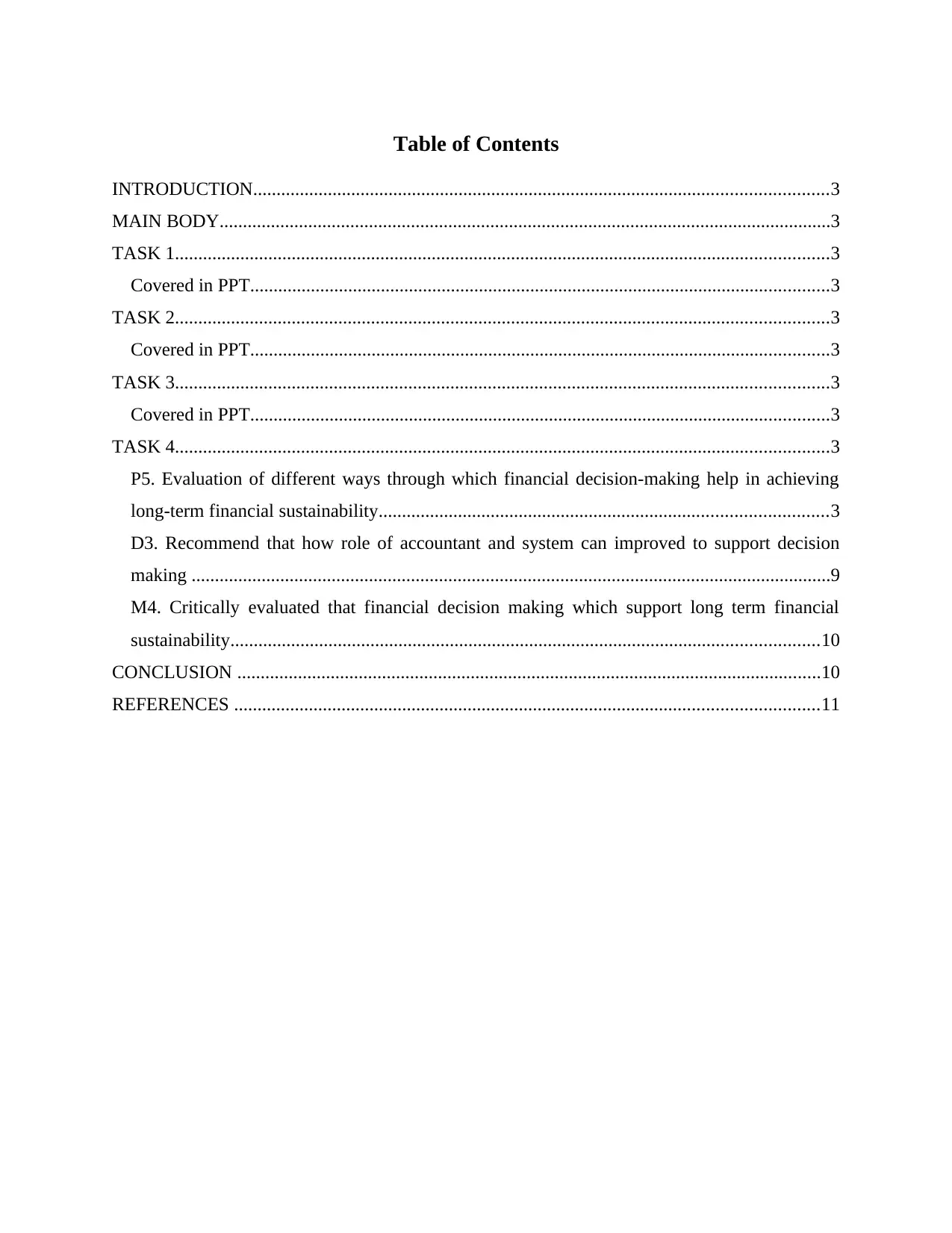
Table of Contents
INTRODUCTION...........................................................................................................................3
MAIN BODY...................................................................................................................................3
TASK 1............................................................................................................................................3
Covered in PPT............................................................................................................................3
TASK 2............................................................................................................................................3
Covered in PPT............................................................................................................................3
TASK 3............................................................................................................................................3
Covered in PPT............................................................................................................................3
TASK 4............................................................................................................................................3
P5. Evaluation of different ways through which financial decision-making help in achieving
long-term financial sustainability................................................................................................3
D3. Recommend that how role of accountant and system can improved to support decision
making .........................................................................................................................................9
M4. Critically evaluated that financial decision making which support long term financial
sustainability..............................................................................................................................10
CONCLUSION .............................................................................................................................10
REFERENCES .............................................................................................................................11
INTRODUCTION...........................................................................................................................3
MAIN BODY...................................................................................................................................3
TASK 1............................................................................................................................................3
Covered in PPT............................................................................................................................3
TASK 2............................................................................................................................................3
Covered in PPT............................................................................................................................3
TASK 3............................................................................................................................................3
Covered in PPT............................................................................................................................3
TASK 4............................................................................................................................................3
P5. Evaluation of different ways through which financial decision-making help in achieving
long-term financial sustainability................................................................................................3
D3. Recommend that how role of accountant and system can improved to support decision
making .........................................................................................................................................9
M4. Critically evaluated that financial decision making which support long term financial
sustainability..............................................................................................................................10
CONCLUSION .............................................................................................................................10
REFERENCES .............................................................................................................................11
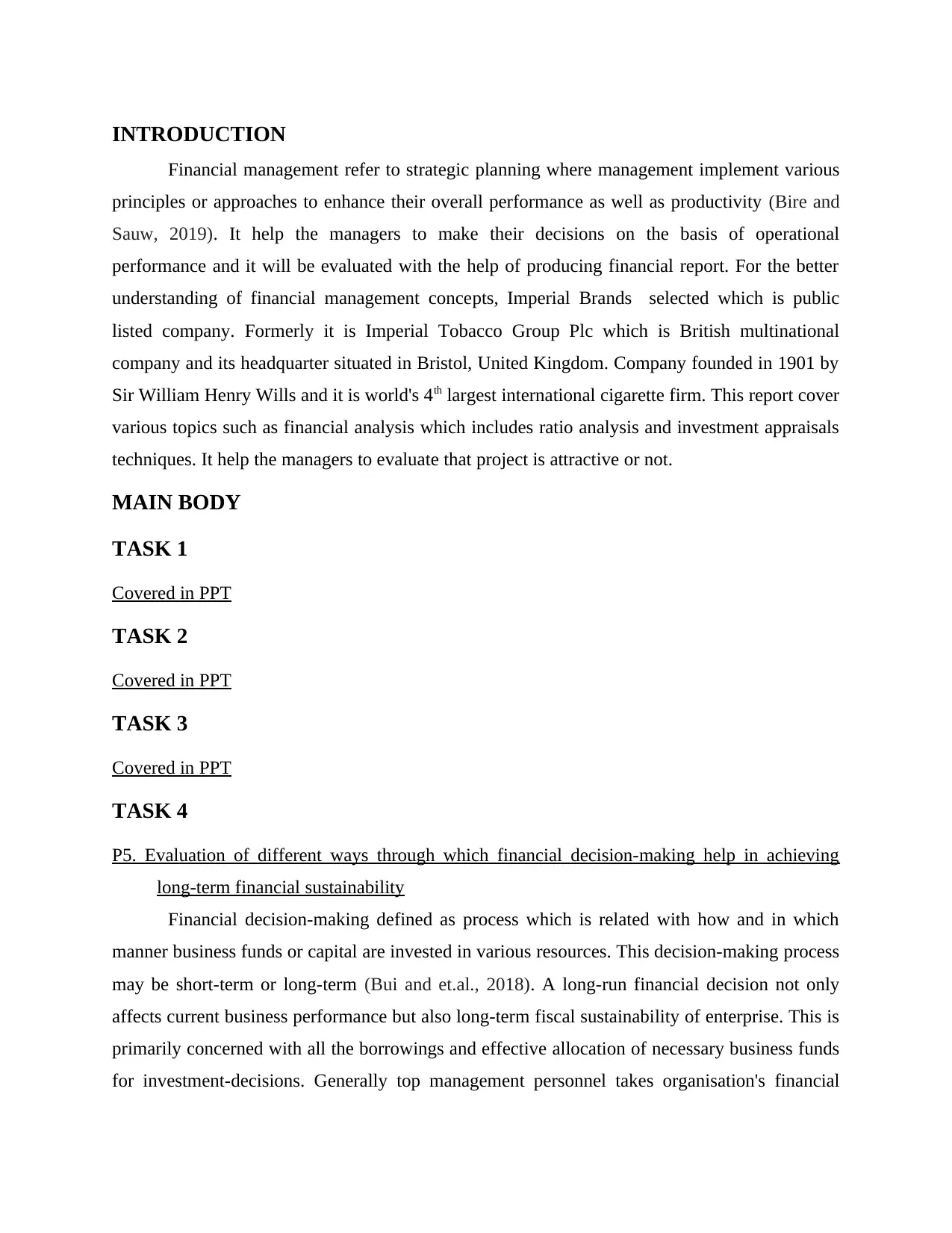
INTRODUCTION
Financial management refer to strategic planning where management implement various
principles or approaches to enhance their overall performance as well as productivity (Bire and
Sauw, 2019). It help the managers to make their decisions on the basis of operational
performance and it will be evaluated with the help of producing financial report. For the better
understanding of financial management concepts, Imperial Brands selected which is public
listed company. Formerly it is Imperial Tobacco Group Plc which is British multinational
company and its headquarter situated in Bristol, United Kingdom. Company founded in 1901 by
Sir William Henry Wills and it is world's 4th largest international cigarette firm. This report cover
various topics such as financial analysis which includes ratio analysis and investment appraisals
techniques. It help the managers to evaluate that project is attractive or not.
MAIN BODY
TASK 1
Covered in PPT
TASK 2
Covered in PPT
TASK 3
Covered in PPT
TASK 4
P5. Evaluation of different ways through which financial decision-making help in achieving
long-term financial sustainability
Financial decision-making defined as process which is related with how and in which
manner business funds or capital are invested in various resources. This decision-making process
may be short-term or long-term (Bui and et.al., 2018). A long-run financial decision not only
affects current business performance but also long-term fiscal sustainability of enterprise. This is
primarily concerned with all the borrowings and effective allocation of necessary business funds
for investment-decisions. Generally top management personnel takes organisation's financial
Financial management refer to strategic planning where management implement various
principles or approaches to enhance their overall performance as well as productivity (Bire and
Sauw, 2019). It help the managers to make their decisions on the basis of operational
performance and it will be evaluated with the help of producing financial report. For the better
understanding of financial management concepts, Imperial Brands selected which is public
listed company. Formerly it is Imperial Tobacco Group Plc which is British multinational
company and its headquarter situated in Bristol, United Kingdom. Company founded in 1901 by
Sir William Henry Wills and it is world's 4th largest international cigarette firm. This report cover
various topics such as financial analysis which includes ratio analysis and investment appraisals
techniques. It help the managers to evaluate that project is attractive or not.
MAIN BODY
TASK 1
Covered in PPT
TASK 2
Covered in PPT
TASK 3
Covered in PPT
TASK 4
P5. Evaluation of different ways through which financial decision-making help in achieving
long-term financial sustainability
Financial decision-making defined as process which is related with how and in which
manner business funds or capital are invested in various resources. This decision-making process
may be short-term or long-term (Bui and et.al., 2018). A long-run financial decision not only
affects current business performance but also long-term fiscal sustainability of enterprise. This is
primarily concerned with all the borrowings and effective allocation of necessary business funds
for investment-decisions. Generally top management personnel takes organisation's financial
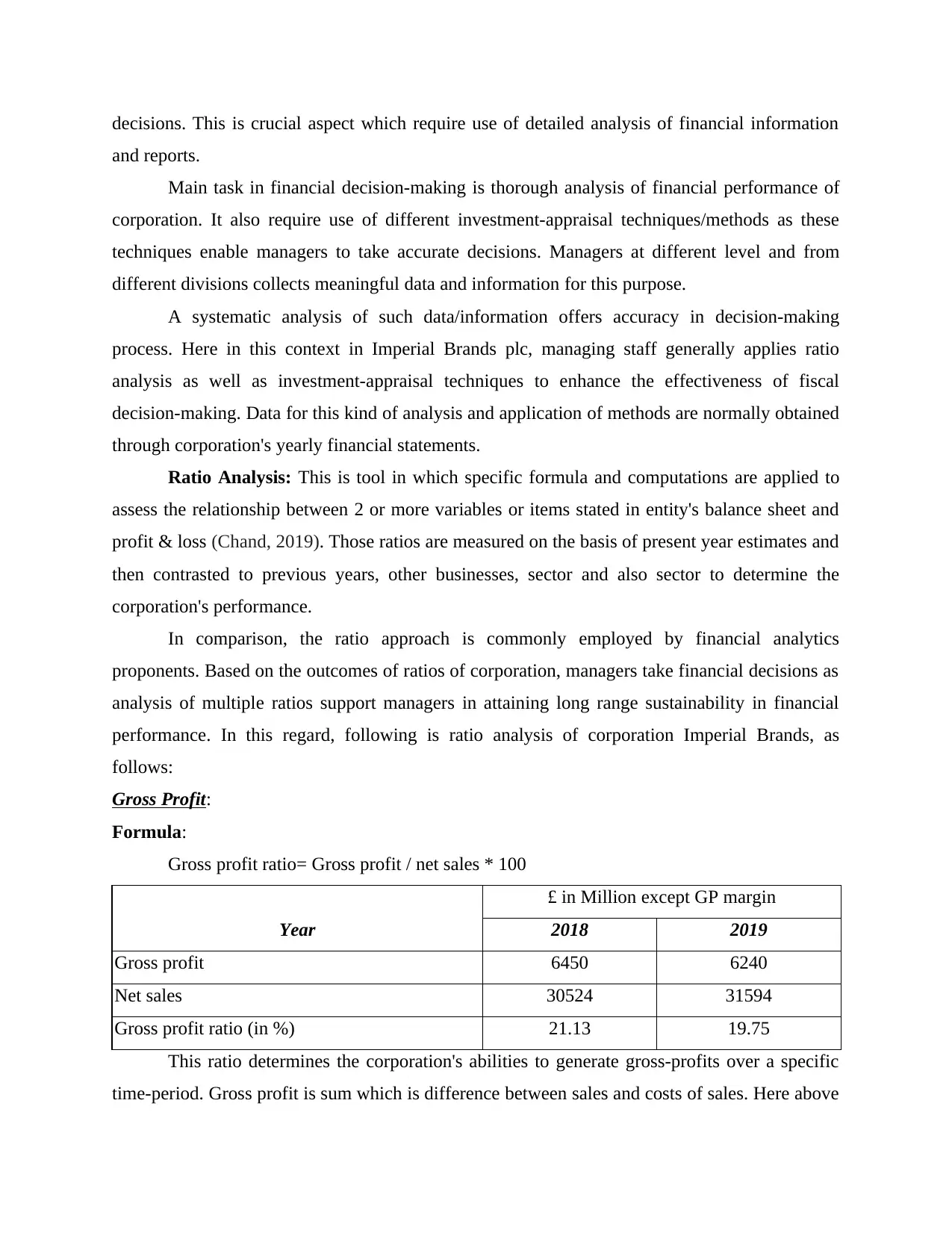
decisions. This is crucial aspect which require use of detailed analysis of financial information
and reports.
Main task in financial decision-making is thorough analysis of financial performance of
corporation. It also require use of different investment-appraisal techniques/methods as these
techniques enable managers to take accurate decisions. Managers at different level and from
different divisions collects meaningful data and information for this purpose.
A systematic analysis of such data/information offers accuracy in decision-making
process. Here in this context in Imperial Brands plc, managing staff generally applies ratio
analysis as well as investment-appraisal techniques to enhance the effectiveness of fiscal
decision-making. Data for this kind of analysis and application of methods are normally obtained
through corporation's yearly financial statements.
Ratio Analysis: This is tool in which specific formula and computations are applied to
assess the relationship between 2 or more variables or items stated in entity's balance sheet and
profit & loss (Chand, 2019). Those ratios are measured on the basis of present year estimates and
then contrasted to previous years, other businesses, sector and also sector to determine the
corporation's performance.
In comparison, the ratio approach is commonly employed by financial analytics
proponents. Based on the outcomes of ratios of corporation, managers take financial decisions as
analysis of multiple ratios support managers in attaining long range sustainability in financial
performance. In this regard, following is ratio analysis of corporation Imperial Brands, as
follows:
Gross Profit:
Formula:
Gross profit ratio= Gross profit / net sales * 100
Year
£ in Million except GP margin
2018 2019
Gross profit 6450 6240
Net sales 30524 31594
Gross profit ratio (in %) 21.13 19.75
This ratio determines the corporation's abilities to generate gross-profits over a specific
time-period. Gross profit is sum which is difference between sales and costs of sales. Here above
and reports.
Main task in financial decision-making is thorough analysis of financial performance of
corporation. It also require use of different investment-appraisal techniques/methods as these
techniques enable managers to take accurate decisions. Managers at different level and from
different divisions collects meaningful data and information for this purpose.
A systematic analysis of such data/information offers accuracy in decision-making
process. Here in this context in Imperial Brands plc, managing staff generally applies ratio
analysis as well as investment-appraisal techniques to enhance the effectiveness of fiscal
decision-making. Data for this kind of analysis and application of methods are normally obtained
through corporation's yearly financial statements.
Ratio Analysis: This is tool in which specific formula and computations are applied to
assess the relationship between 2 or more variables or items stated in entity's balance sheet and
profit & loss (Chand, 2019). Those ratios are measured on the basis of present year estimates and
then contrasted to previous years, other businesses, sector and also sector to determine the
corporation's performance.
In comparison, the ratio approach is commonly employed by financial analytics
proponents. Based on the outcomes of ratios of corporation, managers take financial decisions as
analysis of multiple ratios support managers in attaining long range sustainability in financial
performance. In this regard, following is ratio analysis of corporation Imperial Brands, as
follows:
Gross Profit:
Formula:
Gross profit ratio= Gross profit / net sales * 100
Year
£ in Million except GP margin
2018 2019
Gross profit 6450 6240
Net sales 30524 31594
Gross profit ratio (in %) 21.13 19.75
This ratio determines the corporation's abilities to generate gross-profits over a specific
time-period. Gross profit is sum which is difference between sales and costs of sales. Here above
Secure Best Marks with AI Grader
Need help grading? Try our AI Grader for instant feedback on your assignments.
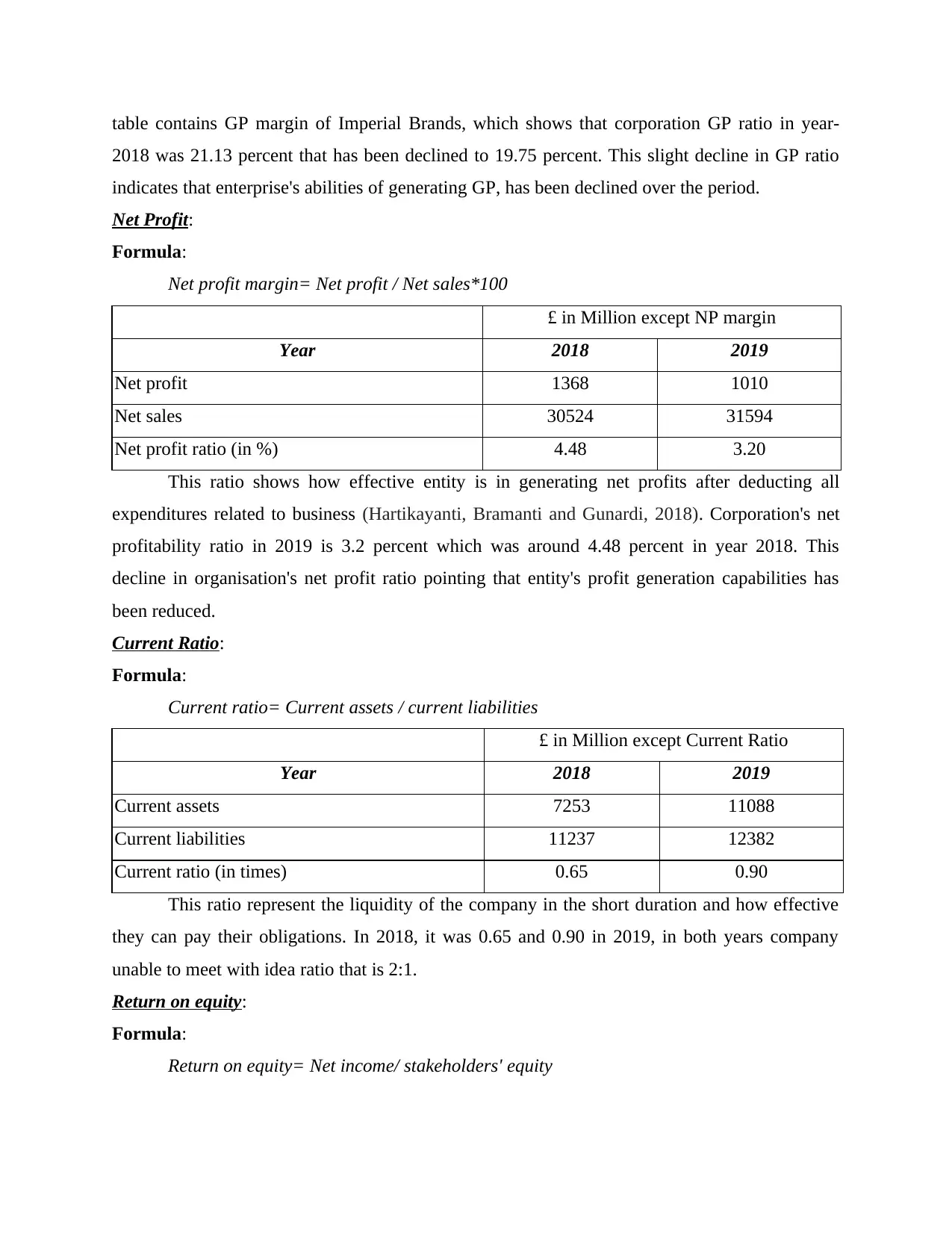
table contains GP margin of Imperial Brands, which shows that corporation GP ratio in year-
2018 was 21.13 percent that has been declined to 19.75 percent. This slight decline in GP ratio
indicates that enterprise's abilities of generating GP, has been declined over the period.
Net Profit:
Formula:
Net profit margin= Net profit / Net sales*100
£ in Million except NP margin
Year 2018 2019
Net profit 1368 1010
Net sales 30524 31594
Net profit ratio (in %) 4.48 3.20
This ratio shows how effective entity is in generating net profits after deducting all
expenditures related to business (Hartikayanti, Bramanti and Gunardi, 2018). Corporation's net
profitability ratio in 2019 is 3.2 percent which was around 4.48 percent in year 2018. This
decline in organisation's net profit ratio pointing that entity's profit generation capabilities has
been reduced.
Current Ratio:
Formula:
Current ratio= Current assets / current liabilities
£ in Million except Current Ratio
Year 2018 2019
Current assets 7253 11088
Current liabilities 11237 12382
Current ratio (in times) 0.65 0.90
This ratio represent the liquidity of the company in the short duration and how effective
they can pay their obligations. In 2018, it was 0.65 and 0.90 in 2019, in both years company
unable to meet with idea ratio that is 2:1.
Return on equity:
Formula:
Return on equity= Net income/ stakeholders' equity
2018 was 21.13 percent that has been declined to 19.75 percent. This slight decline in GP ratio
indicates that enterprise's abilities of generating GP, has been declined over the period.
Net Profit:
Formula:
Net profit margin= Net profit / Net sales*100
£ in Million except NP margin
Year 2018 2019
Net profit 1368 1010
Net sales 30524 31594
Net profit ratio (in %) 4.48 3.20
This ratio shows how effective entity is in generating net profits after deducting all
expenditures related to business (Hartikayanti, Bramanti and Gunardi, 2018). Corporation's net
profitability ratio in 2019 is 3.2 percent which was around 4.48 percent in year 2018. This
decline in organisation's net profit ratio pointing that entity's profit generation capabilities has
been reduced.
Current Ratio:
Formula:
Current ratio= Current assets / current liabilities
£ in Million except Current Ratio
Year 2018 2019
Current assets 7253 11088
Current liabilities 11237 12382
Current ratio (in times) 0.65 0.90
This ratio represent the liquidity of the company in the short duration and how effective
they can pay their obligations. In 2018, it was 0.65 and 0.90 in 2019, in both years company
unable to meet with idea ratio that is 2:1.
Return on equity:
Formula:
Return on equity= Net income/ stakeholders' equity
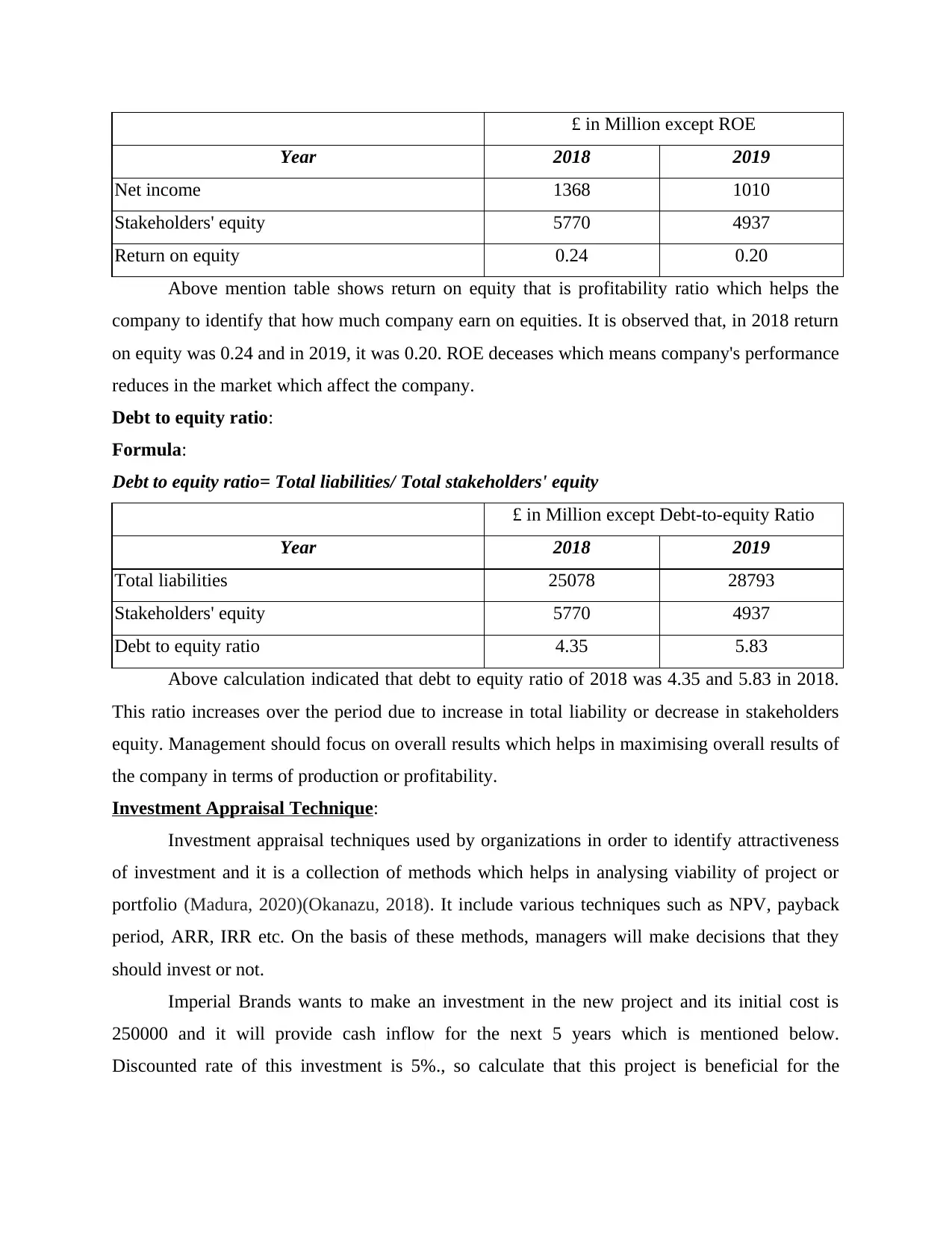
£ in Million except ROE
Year 2018 2019
Net income 1368 1010
Stakeholders' equity 5770 4937
Return on equity 0.24 0.20
Above mention table shows return on equity that is profitability ratio which helps the
company to identify that how much company earn on equities. It is observed that, in 2018 return
on equity was 0.24 and in 2019, it was 0.20. ROE deceases which means company's performance
reduces in the market which affect the company.
Debt to equity ratio:
Formula:
Debt to equity ratio= Total liabilities/ Total stakeholders' equity
£ in Million except Debt-to-equity Ratio
Year 2018 2019
Total liabilities 25078 28793
Stakeholders' equity 5770 4937
Debt to equity ratio 4.35 5.83
Above calculation indicated that debt to equity ratio of 2018 was 4.35 and 5.83 in 2018.
This ratio increases over the period due to increase in total liability or decrease in stakeholders
equity. Management should focus on overall results which helps in maximising overall results of
the company in terms of production or profitability.
Investment Appraisal Technique:
Investment appraisal techniques used by organizations in order to identify attractiveness
of investment and it is a collection of methods which helps in analysing viability of project or
portfolio (Madura, 2020)(Okanazu, 2018). It include various techniques such as NPV, payback
period, ARR, IRR etc. On the basis of these methods, managers will make decisions that they
should invest or not.
Imperial Brands wants to make an investment in the new project and its initial cost is
250000 and it will provide cash inflow for the next 5 years which is mentioned below.
Discounted rate of this investment is 5%., so calculate that this project is beneficial for the
Year 2018 2019
Net income 1368 1010
Stakeholders' equity 5770 4937
Return on equity 0.24 0.20
Above mention table shows return on equity that is profitability ratio which helps the
company to identify that how much company earn on equities. It is observed that, in 2018 return
on equity was 0.24 and in 2019, it was 0.20. ROE deceases which means company's performance
reduces in the market which affect the company.
Debt to equity ratio:
Formula:
Debt to equity ratio= Total liabilities/ Total stakeholders' equity
£ in Million except Debt-to-equity Ratio
Year 2018 2019
Total liabilities 25078 28793
Stakeholders' equity 5770 4937
Debt to equity ratio 4.35 5.83
Above calculation indicated that debt to equity ratio of 2018 was 4.35 and 5.83 in 2018.
This ratio increases over the period due to increase in total liability or decrease in stakeholders
equity. Management should focus on overall results which helps in maximising overall results of
the company in terms of production or profitability.
Investment Appraisal Technique:
Investment appraisal techniques used by organizations in order to identify attractiveness
of investment and it is a collection of methods which helps in analysing viability of project or
portfolio (Madura, 2020)(Okanazu, 2018). It include various techniques such as NPV, payback
period, ARR, IRR etc. On the basis of these methods, managers will make decisions that they
should invest or not.
Imperial Brands wants to make an investment in the new project and its initial cost is
250000 and it will provide cash inflow for the next 5 years which is mentioned below.
Discounted rate of this investment is 5%., so calculate that this project is beneficial for the
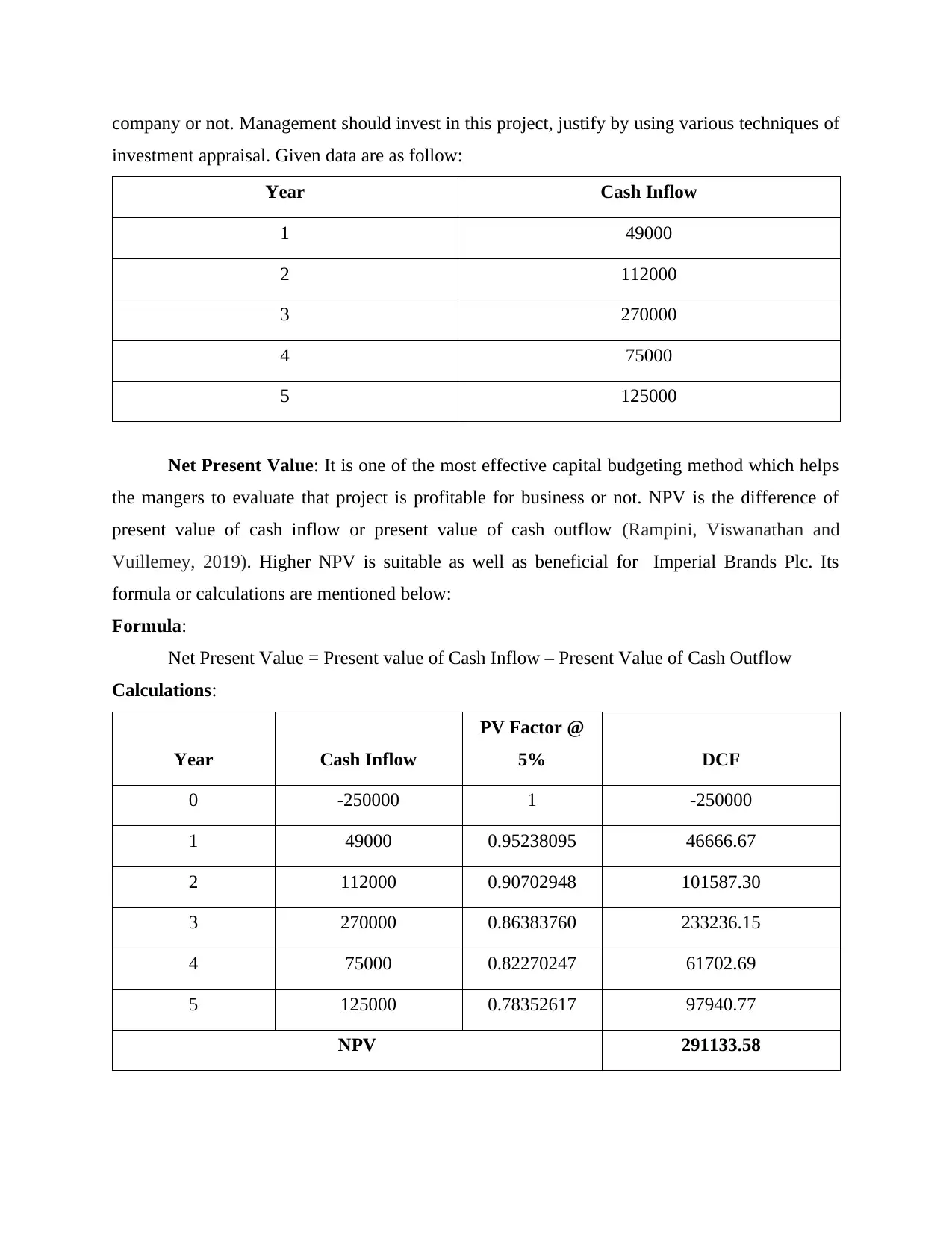
company or not. Management should invest in this project, justify by using various techniques of
investment appraisal. Given data are as follow:
Year Cash Inflow
1 49000
2 112000
3 270000
4 75000
5 125000
Net Present Value: It is one of the most effective capital budgeting method which helps
the mangers to evaluate that project is profitable for business or not. NPV is the difference of
present value of cash inflow or present value of cash outflow (Rampini, Viswanathan and
Vuillemey, 2019). Higher NPV is suitable as well as beneficial for Imperial Brands Plc. Its
formula or calculations are mentioned below:
Formula:
Net Present Value = Present value of Cash Inflow – Present Value of Cash Outflow
Calculations:
Year Cash Inflow
PV Factor @
5% DCF
0 -250000 1 -250000
1 49000 0.95238095 46666.67
2 112000 0.90702948 101587.30
3 270000 0.86383760 233236.15
4 75000 0.82270247 61702.69
5 125000 0.78352617 97940.77
NPV 291133.58
investment appraisal. Given data are as follow:
Year Cash Inflow
1 49000
2 112000
3 270000
4 75000
5 125000
Net Present Value: It is one of the most effective capital budgeting method which helps
the mangers to evaluate that project is profitable for business or not. NPV is the difference of
present value of cash inflow or present value of cash outflow (Rampini, Viswanathan and
Vuillemey, 2019). Higher NPV is suitable as well as beneficial for Imperial Brands Plc. Its
formula or calculations are mentioned below:
Formula:
Net Present Value = Present value of Cash Inflow – Present Value of Cash Outflow
Calculations:
Year Cash Inflow
PV Factor @
5% DCF
0 -250000 1 -250000
1 49000 0.95238095 46666.67
2 112000 0.90702948 101587.30
3 270000 0.86383760 233236.15
4 75000 0.82270247 61702.69
5 125000 0.78352617 97940.77
NPV 291133.58
Paraphrase This Document
Need a fresh take? Get an instant paraphrase of this document with our AI Paraphraser
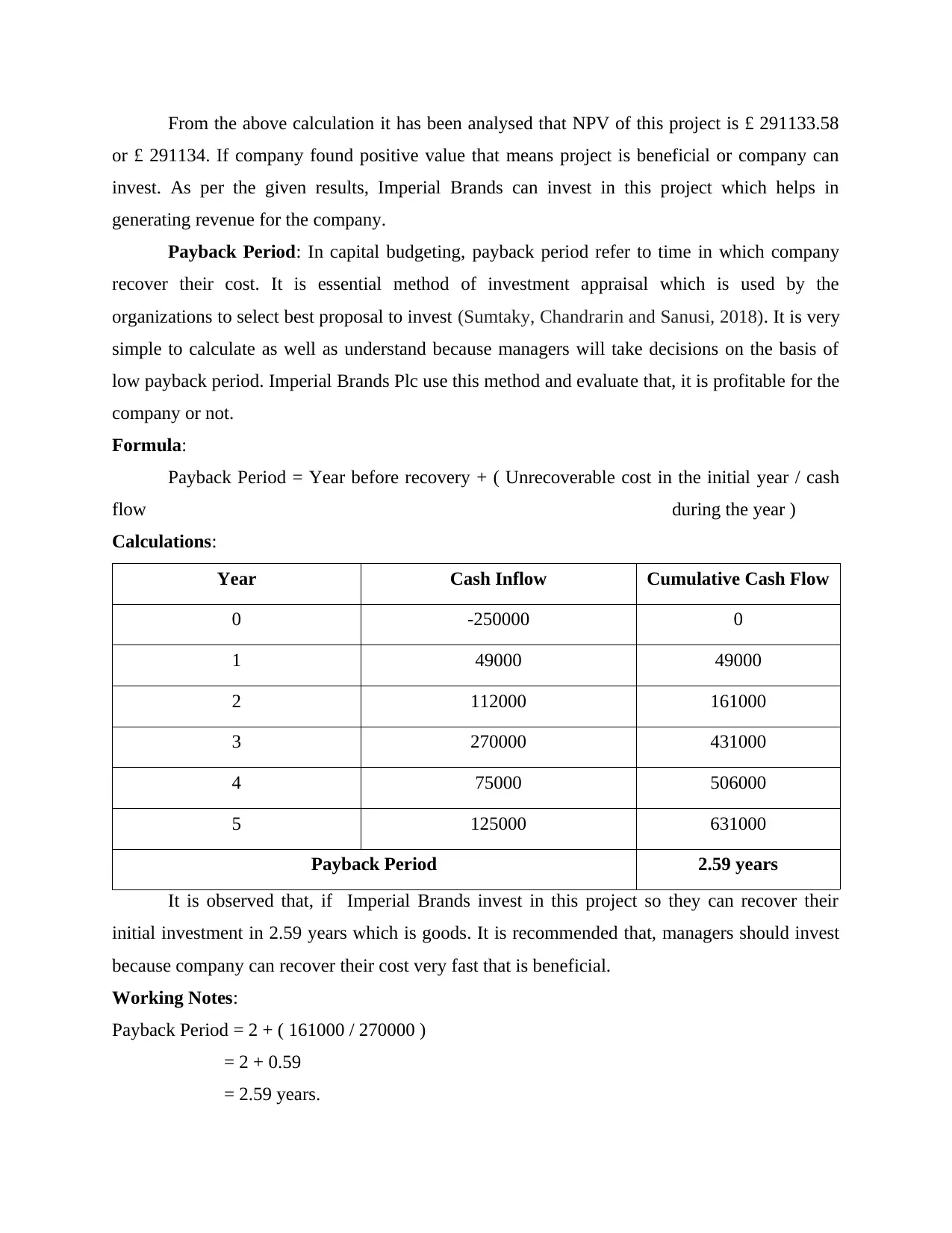
From the above calculation it has been analysed that NPV of this project is £ 291133.58
or £ 291134. If company found positive value that means project is beneficial or company can
invest. As per the given results, Imperial Brands can invest in this project which helps in
generating revenue for the company.
Payback Period: In capital budgeting, payback period refer to time in which company
recover their cost. It is essential method of investment appraisal which is used by the
organizations to select best proposal to invest (Sumtaky, Chandrarin and Sanusi, 2018). It is very
simple to calculate as well as understand because managers will take decisions on the basis of
low payback period. Imperial Brands Plc use this method and evaluate that, it is profitable for the
company or not.
Formula:
Payback Period = Year before recovery + ( Unrecoverable cost in the initial year / cash
flow during the year )
Calculations:
Year Cash Inflow Cumulative Cash Flow
0 -250000 0
1 49000 49000
2 112000 161000
3 270000 431000
4 75000 506000
5 125000 631000
Payback Period 2.59 years
It is observed that, if Imperial Brands invest in this project so they can recover their
initial investment in 2.59 years which is goods. It is recommended that, managers should invest
because company can recover their cost very fast that is beneficial.
Working Notes:
Payback Period = 2 + ( 161000 / 270000 )
= 2 + 0.59
= 2.59 years.
or £ 291134. If company found positive value that means project is beneficial or company can
invest. As per the given results, Imperial Brands can invest in this project which helps in
generating revenue for the company.
Payback Period: In capital budgeting, payback period refer to time in which company
recover their cost. It is essential method of investment appraisal which is used by the
organizations to select best proposal to invest (Sumtaky, Chandrarin and Sanusi, 2018). It is very
simple to calculate as well as understand because managers will take decisions on the basis of
low payback period. Imperial Brands Plc use this method and evaluate that, it is profitable for the
company or not.
Formula:
Payback Period = Year before recovery + ( Unrecoverable cost in the initial year / cash
flow during the year )
Calculations:
Year Cash Inflow Cumulative Cash Flow
0 -250000 0
1 49000 49000
2 112000 161000
3 270000 431000
4 75000 506000
5 125000 631000
Payback Period 2.59 years
It is observed that, if Imperial Brands invest in this project so they can recover their
initial investment in 2.59 years which is goods. It is recommended that, managers should invest
because company can recover their cost very fast that is beneficial.
Working Notes:
Payback Period = 2 + ( 161000 / 270000 )
= 2 + 0.59
= 2.59 years.
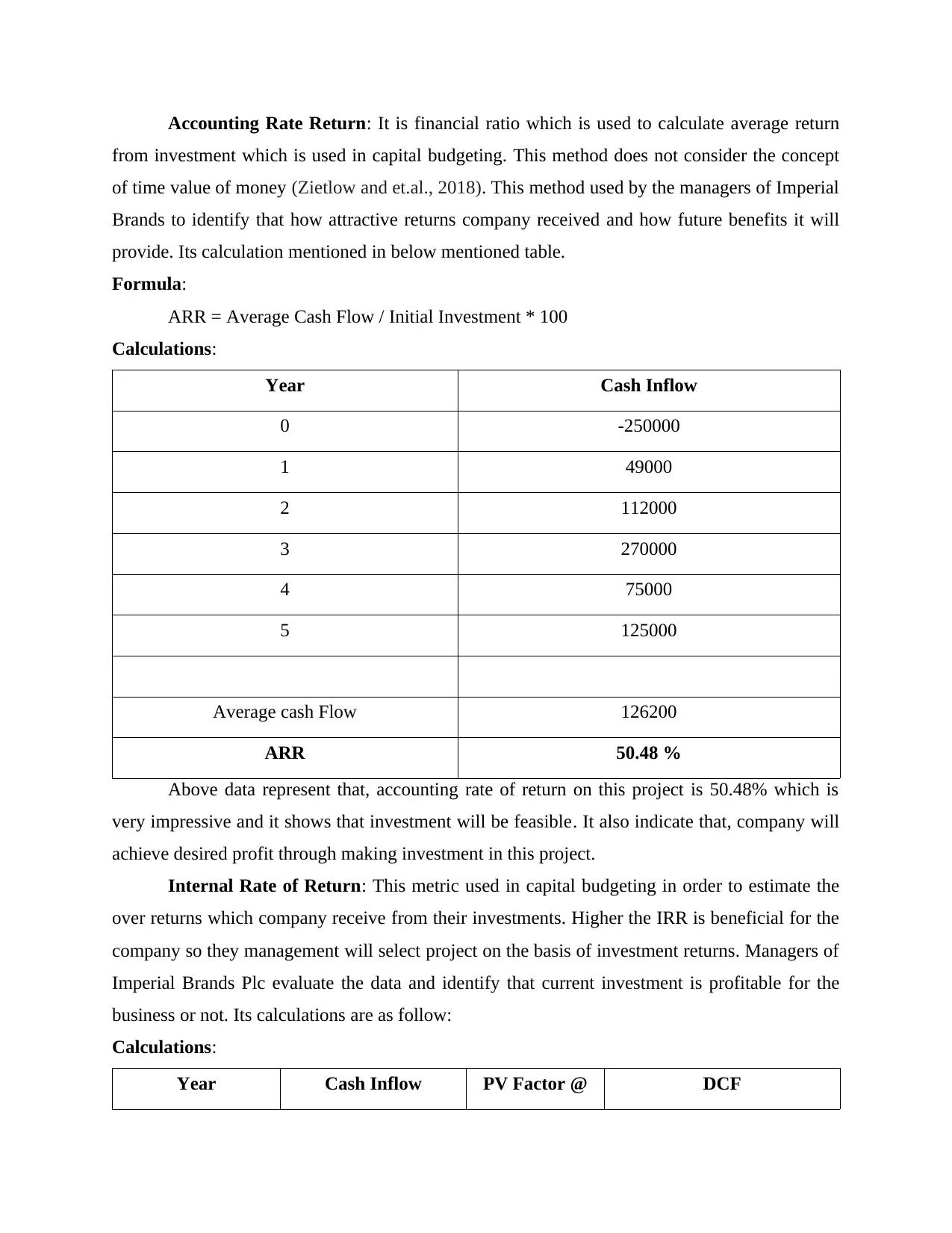
Accounting Rate Return: It is financial ratio which is used to calculate average return
from investment which is used in capital budgeting. This method does not consider the concept
of time value of money (Zietlow and et.al., 2018). This method used by the managers of Imperial
Brands to identify that how attractive returns company received and how future benefits it will
provide. Its calculation mentioned in below mentioned table.
Formula:
ARR = Average Cash Flow / Initial Investment * 100
Calculations:
Year Cash Inflow
0 -250000
1 49000
2 112000
3 270000
4 75000
5 125000
Average cash Flow 126200
ARR 50.48 %
Above data represent that, accounting rate of return on this project is 50.48% which is
very impressive and it shows that investment will be feasible. It also indicate that, company will
achieve desired profit through making investment in this project.
Internal Rate of Return: This metric used in capital budgeting in order to estimate the
over returns which company receive from their investments. Higher the IRR is beneficial for the
company so they management will select project on the basis of investment returns. Managers of
Imperial Brands Plc evaluate the data and identify that current investment is profitable for the
business or not. Its calculations are as follow:
Calculations:
Year Cash Inflow PV Factor @ DCF
from investment which is used in capital budgeting. This method does not consider the concept
of time value of money (Zietlow and et.al., 2018). This method used by the managers of Imperial
Brands to identify that how attractive returns company received and how future benefits it will
provide. Its calculation mentioned in below mentioned table.
Formula:
ARR = Average Cash Flow / Initial Investment * 100
Calculations:
Year Cash Inflow
0 -250000
1 49000
2 112000
3 270000
4 75000
5 125000
Average cash Flow 126200
ARR 50.48 %
Above data represent that, accounting rate of return on this project is 50.48% which is
very impressive and it shows that investment will be feasible. It also indicate that, company will
achieve desired profit through making investment in this project.
Internal Rate of Return: This metric used in capital budgeting in order to estimate the
over returns which company receive from their investments. Higher the IRR is beneficial for the
company so they management will select project on the basis of investment returns. Managers of
Imperial Brands Plc evaluate the data and identify that current investment is profitable for the
business or not. Its calculations are as follow:
Calculations:
Year Cash Inflow PV Factor @ DCF
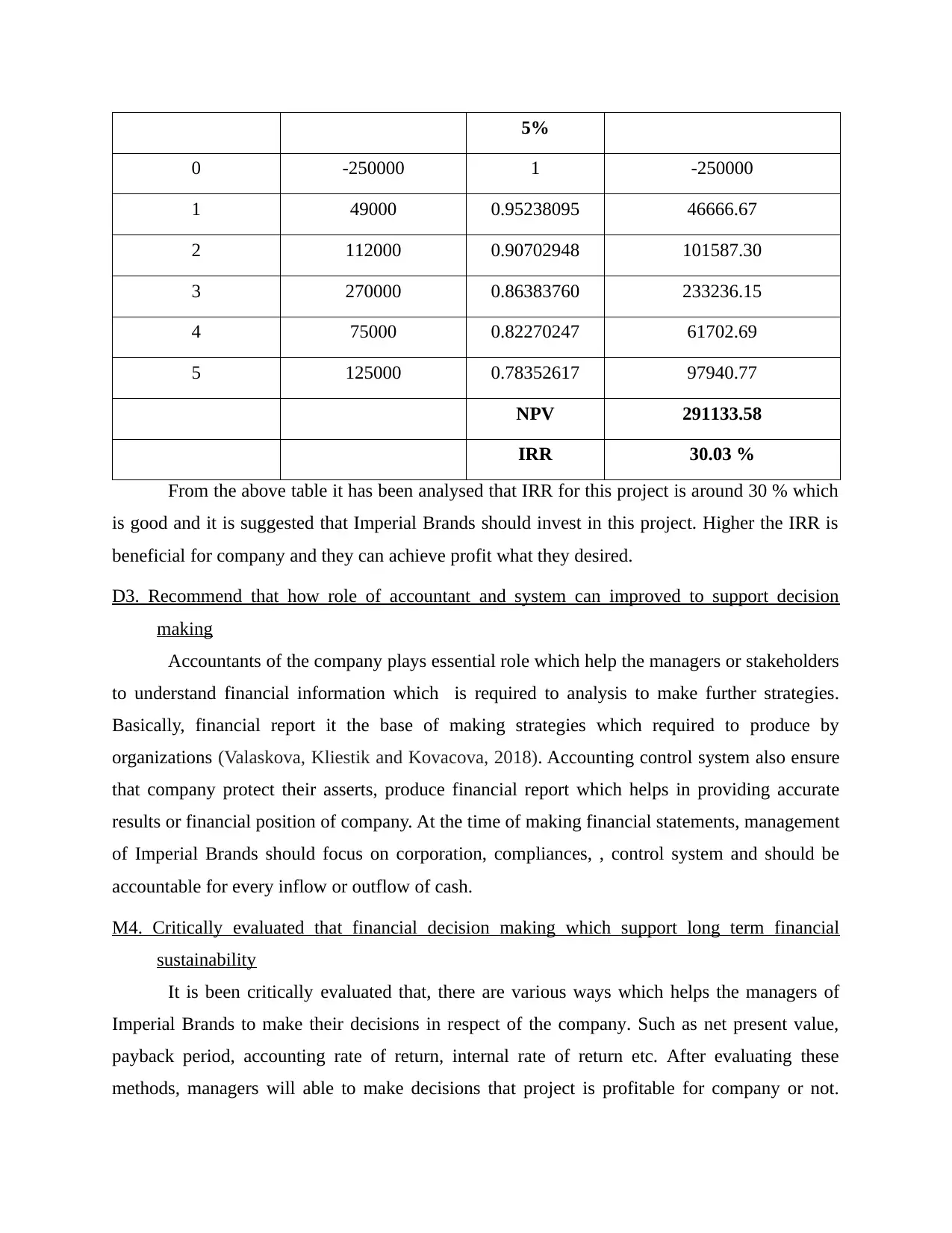
5%
0 -250000 1 -250000
1 49000 0.95238095 46666.67
2 112000 0.90702948 101587.30
3 270000 0.86383760 233236.15
4 75000 0.82270247 61702.69
5 125000 0.78352617 97940.77
NPV 291133.58
IRR 30.03 %
From the above table it has been analysed that IRR for this project is around 30 % which
is good and it is suggested that Imperial Brands should invest in this project. Higher the IRR is
beneficial for company and they can achieve profit what they desired.
D3. Recommend that how role of accountant and system can improved to support decision
making
Accountants of the company plays essential role which help the managers or stakeholders
to understand financial information which is required to analysis to make further strategies.
Basically, financial report it the base of making strategies which required to produce by
organizations (Valaskova, Kliestik and Kovacova, 2018). Accounting control system also ensure
that company protect their asserts, produce financial report which helps in providing accurate
results or financial position of company. At the time of making financial statements, management
of Imperial Brands should focus on corporation, compliances, , control system and should be
accountable for every inflow or outflow of cash.
M4. Critically evaluated that financial decision making which support long term financial
sustainability
It is been critically evaluated that, there are various ways which helps the managers of
Imperial Brands to make their decisions in respect of the company. Such as net present value,
payback period, accounting rate of return, internal rate of return etc. After evaluating these
methods, managers will able to make decisions that project is profitable for company or not.
0 -250000 1 -250000
1 49000 0.95238095 46666.67
2 112000 0.90702948 101587.30
3 270000 0.86383760 233236.15
4 75000 0.82270247 61702.69
5 125000 0.78352617 97940.77
NPV 291133.58
IRR 30.03 %
From the above table it has been analysed that IRR for this project is around 30 % which
is good and it is suggested that Imperial Brands should invest in this project. Higher the IRR is
beneficial for company and they can achieve profit what they desired.
D3. Recommend that how role of accountant and system can improved to support decision
making
Accountants of the company plays essential role which help the managers or stakeholders
to understand financial information which is required to analysis to make further strategies.
Basically, financial report it the base of making strategies which required to produce by
organizations (Valaskova, Kliestik and Kovacova, 2018). Accounting control system also ensure
that company protect their asserts, produce financial report which helps in providing accurate
results or financial position of company. At the time of making financial statements, management
of Imperial Brands should focus on corporation, compliances, , control system and should be
accountable for every inflow or outflow of cash.
M4. Critically evaluated that financial decision making which support long term financial
sustainability
It is been critically evaluated that, there are various ways which helps the managers of
Imperial Brands to make their decisions in respect of the company. Such as net present value,
payback period, accounting rate of return, internal rate of return etc. After evaluating these
methods, managers will able to make decisions that project is profitable for company or not.
Secure Best Marks with AI Grader
Need help grading? Try our AI Grader for instant feedback on your assignments.
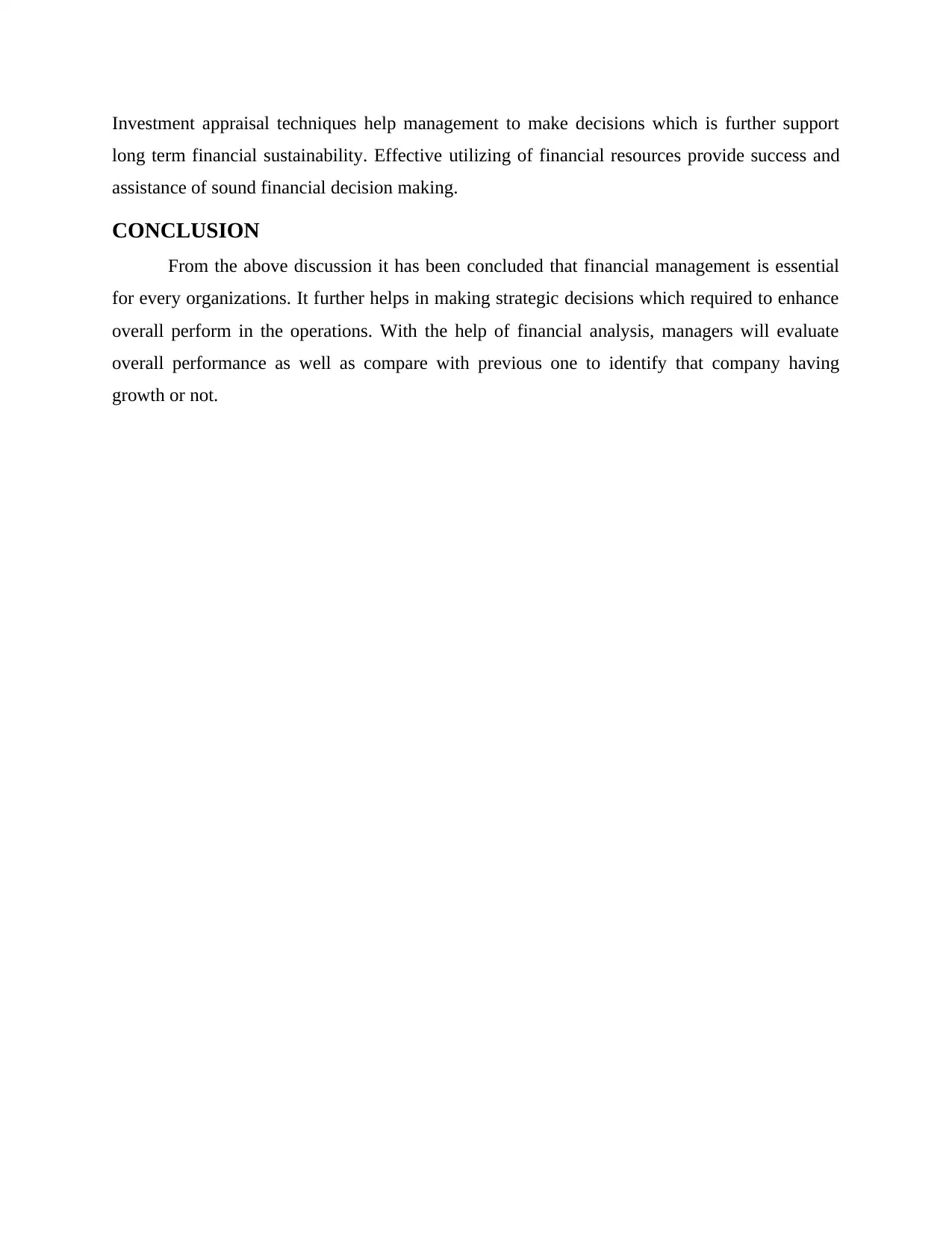
Investment appraisal techniques help management to make decisions which is further support
long term financial sustainability. Effective utilizing of financial resources provide success and
assistance of sound financial decision making.
CONCLUSION
From the above discussion it has been concluded that financial management is essential
for every organizations. It further helps in making strategic decisions which required to enhance
overall perform in the operations. With the help of financial analysis, managers will evaluate
overall performance as well as compare with previous one to identify that company having
growth or not.
long term financial sustainability. Effective utilizing of financial resources provide success and
assistance of sound financial decision making.
CONCLUSION
From the above discussion it has been concluded that financial management is essential
for every organizations. It further helps in making strategic decisions which required to enhance
overall perform in the operations. With the help of financial analysis, managers will evaluate
overall performance as well as compare with previous one to identify that company having
growth or not.
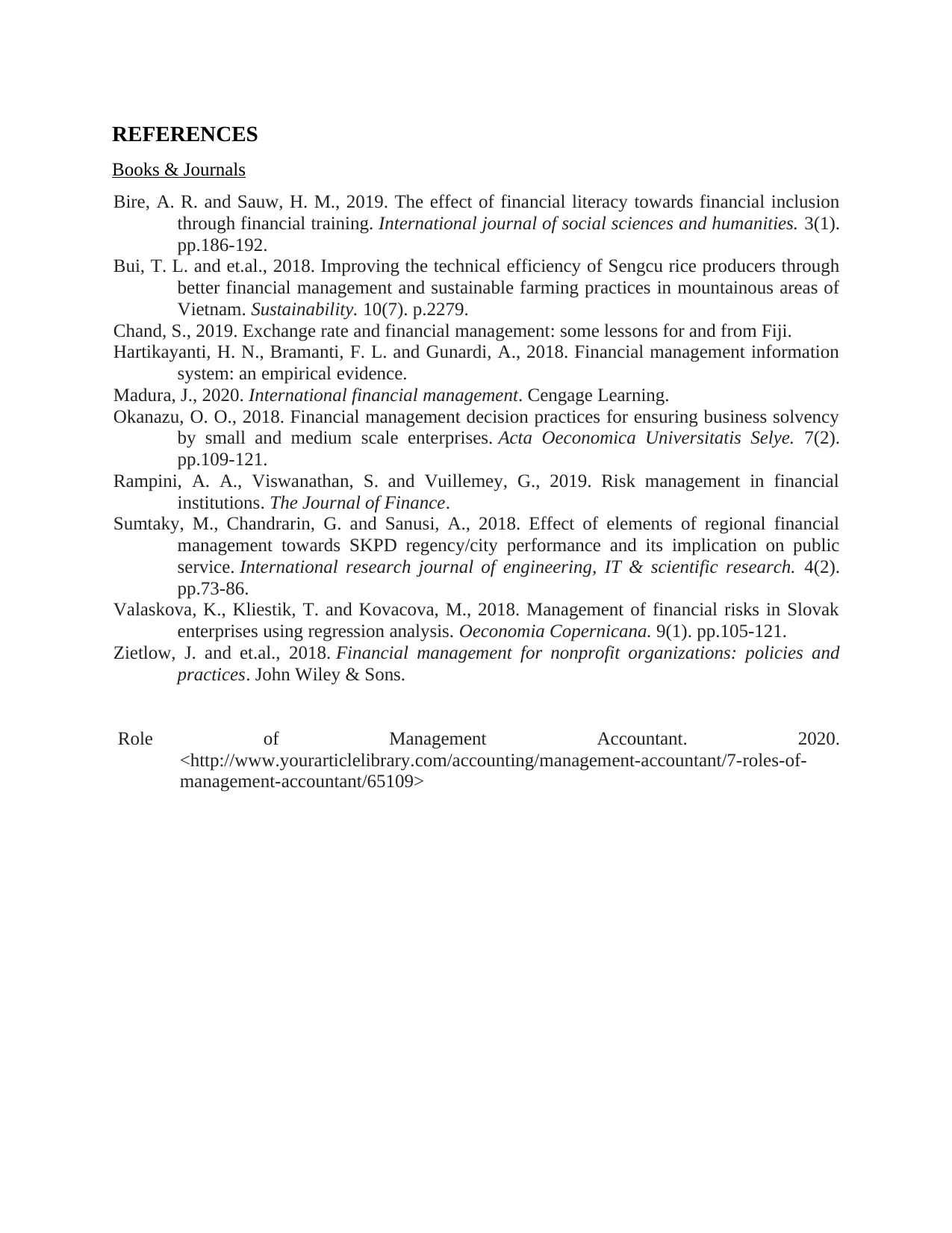
REFERENCES
Books & Journals
Bire, A. R. and Sauw, H. M., 2019. The effect of financial literacy towards financial inclusion
through financial training. International journal of social sciences and humanities. 3(1).
pp.186-192.
Bui, T. L. and et.al., 2018. Improving the technical efficiency of Sengcu rice producers through
better financial management and sustainable farming practices in mountainous areas of
Vietnam. Sustainability. 10(7). p.2279.
Chand, S., 2019. Exchange rate and financial management: some lessons for and from Fiji.
Hartikayanti, H. N., Bramanti, F. L. and Gunardi, A., 2018. Financial management information
system: an empirical evidence.
Madura, J., 2020. International financial management. Cengage Learning.
Okanazu, O. O., 2018. Financial management decision practices for ensuring business solvency
by small and medium scale enterprises. Acta Oeconomica Universitatis Selye. 7(2).
pp.109-121.
Rampini, A. A., Viswanathan, S. and Vuillemey, G., 2019. Risk management in financial
institutions. The Journal of Finance.
Sumtaky, M., Chandrarin, G. and Sanusi, A., 2018. Effect of elements of regional financial
management towards SKPD regency/city performance and its implication on public
service. International research journal of engineering, IT & scientific research. 4(2).
pp.73-86.
Valaskova, K., Kliestik, T. and Kovacova, M., 2018. Management of financial risks in Slovak
enterprises using regression analysis. Oeconomia Copernicana. 9(1). pp.105-121.
Zietlow, J. and et.al., 2018. Financial management for nonprofit organizations: policies and
practices. John Wiley & Sons.
Role of Management Accountant. 2020.
<http://www.yourarticlelibrary.com/accounting/management-accountant/7-roles-of-
management-accountant/65109>
Books & Journals
Bire, A. R. and Sauw, H. M., 2019. The effect of financial literacy towards financial inclusion
through financial training. International journal of social sciences and humanities. 3(1).
pp.186-192.
Bui, T. L. and et.al., 2018. Improving the technical efficiency of Sengcu rice producers through
better financial management and sustainable farming practices in mountainous areas of
Vietnam. Sustainability. 10(7). p.2279.
Chand, S., 2019. Exchange rate and financial management: some lessons for and from Fiji.
Hartikayanti, H. N., Bramanti, F. L. and Gunardi, A., 2018. Financial management information
system: an empirical evidence.
Madura, J., 2020. International financial management. Cengage Learning.
Okanazu, O. O., 2018. Financial management decision practices for ensuring business solvency
by small and medium scale enterprises. Acta Oeconomica Universitatis Selye. 7(2).
pp.109-121.
Rampini, A. A., Viswanathan, S. and Vuillemey, G., 2019. Risk management in financial
institutions. The Journal of Finance.
Sumtaky, M., Chandrarin, G. and Sanusi, A., 2018. Effect of elements of regional financial
management towards SKPD regency/city performance and its implication on public
service. International research journal of engineering, IT & scientific research. 4(2).
pp.73-86.
Valaskova, K., Kliestik, T. and Kovacova, M., 2018. Management of financial risks in Slovak
enterprises using regression analysis. Oeconomia Copernicana. 9(1). pp.105-121.
Zietlow, J. and et.al., 2018. Financial management for nonprofit organizations: policies and
practices. John Wiley & Sons.
Role of Management Accountant. 2020.
<http://www.yourarticlelibrary.com/accounting/management-accountant/7-roles-of-
management-accountant/65109>
1 out of 12
Related Documents
Your All-in-One AI-Powered Toolkit for Academic Success.
+13062052269
info@desklib.com
Available 24*7 on WhatsApp / Email
![[object Object]](/_next/static/media/star-bottom.7253800d.svg)
Unlock your academic potential
© 2024 | Zucol Services PVT LTD | All rights reserved.





